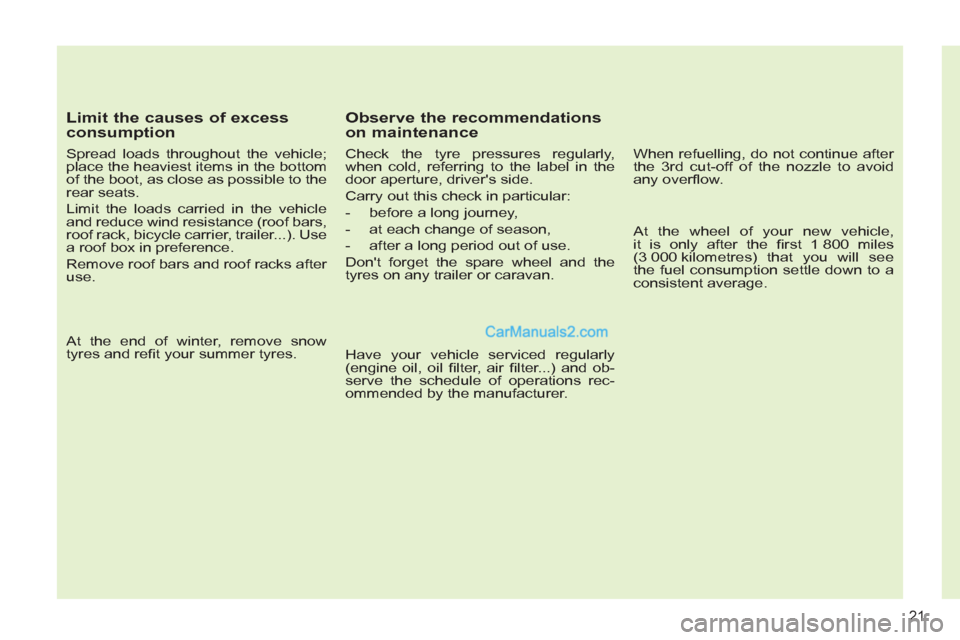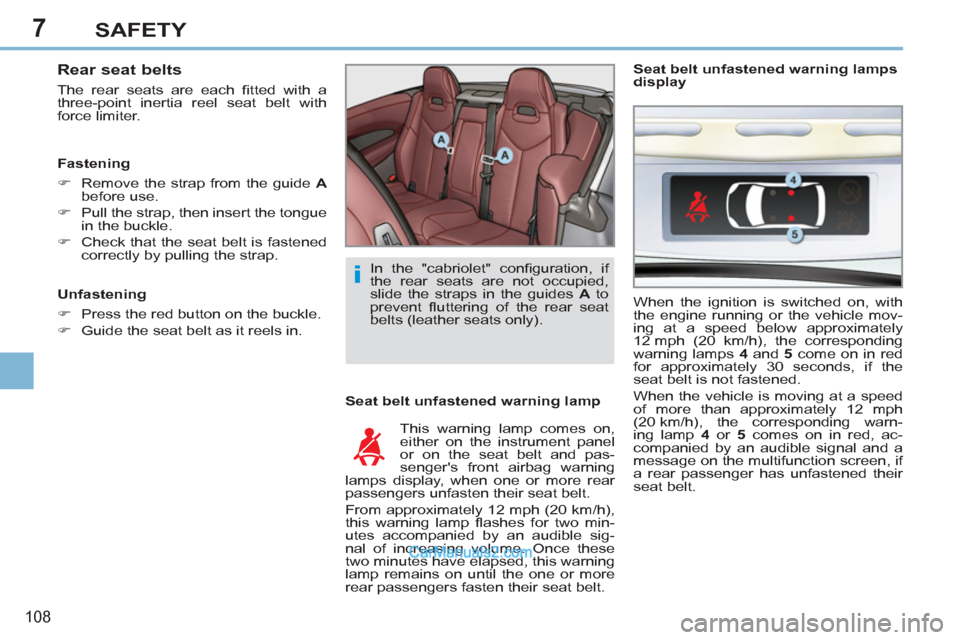Page 23 of 292

21
Limit the causes of excess
consumption
Spread loads throughout the vehicle;
place the heaviest items in the bottom
of the boot, as close as possible to the
rear seats.
Limit the loads carried in the vehicle
and reduce wind resistance (roof bars,
roof rack, bicycle carrier, trailer...). Use
a roof box in preference.
Remove roof bars and roof racks after
use.
At the end of winter, remove snow
tyres and refi t your summer tyres.
Observe the recommendations
on maintenance
Check the tyre pressures regularly,
when cold, referring to the label in the
door aperture, driver's side.
Carry out this check in particular:
- before a long journey,
- at each change of season,
- after a long period out of use.
Don't forget the spare wheel and the
tyres on any trailer or caravan.
Have your vehicle serviced regularly
(engine oil, oil fi lter, air fi lter...) and ob-
serve the schedule of operations rec-
ommended by the manufacturer.
When refuelling, do not continue after
the 3 rd cut-off of the nozzle to avoid
any overfl ow.
At the wheel of your new vehicle,
it is only after the fi rst 1 800 miles
(3 000 kilometres) that you will see
the fuel consumption settle down to a
consistent average.
Page 110 of 292

7
i
108
SAFETY
Rear seat belts
The rear seats are each fi tted with a
three-point inertia reel seat belt with
force limiter.
Seat belt unfastened warning lamp
This warning lamp comes on,
either on the instrument panel
or on the seat belt and pas-
senger's front airbag warning
lamps display, when one or more rear
passengers unfasten their seat belt.
From approximately 12 mph (20 km/h),
this warning lamp fl ashes for two min-
utes accompanied by an audible sig-
nal of increasing volume. Once these
two minutes have elapsed, this warning
lamp remains on until the one or more
rear passengers fasten their seat belt.
Fastening
�)
Remove the strap from the guide A
before use.
�)
Pull the strap, then insert the tongue
in the buckle.
�)
Check that the seat belt is fastened
correctly by pulling the strap.
Seat belt unfastened warning lamps
display
When the ignition is switched on, with
the engine running or the vehicle mov-
ing at a speed below approximately
12 mph (20 km/h), the corresponding
warning lamps 4
and 5
come on in red
for approximately 30 seconds, if the
seat belt is not fastened.
When the vehicle is moving at a speed
of more than approximately 12 mph
(20 km/h), the corresponding warn-
ing lamp 4
or 5
comes on in red, ac-
companied by an audible signal and a
message on the multifunction screen, if
a rear passenger has unfastened their
seat belt.
Unfastening
�)
Press the red button on the buckle.
�)
Guide the seat belt as it reels in. In the "cabriolet" confi guration, if
the rear seats are not occupied,
slide the straps in the guides A
to
prevent fl uttering of the rear seat
belts (leather seats only).
Page 115 of 292

7
!
11 3
SAFETY
For the airbags to be fully
effective, observe the following
safety rules:
Sit in a normal upright position.
Wear a correctly adjusted seat belt.
Do not leave anything between the
occupants and the airbags (a child,
pet, object...). This could hamper the
operation of the airbags or injure the
occupants.
After an accident or if the vehicle has
been stolen or broken into, have the
airbag systems checked.
All work on the airbag system must be
carried out by a PEUGEOT dealer or
a qualifi ed workshop.
Even if all of the precautions mentioned
are observed, a risk of injury or of minor
burns to the head, chest or arms when
an airbag is deployed cannot be ruled
out. The bag infl ates almost instantly
(within a few milliseconds) then defl ates
within the same time discharging the
hot gas via openings provided for this
purpose.
Front airbags
Do not drive holding the steering wheel by its spokes or resting your hands on
the centre part of the wheel.
Passengers must not place their feet on the dashboard.
If possible, do not smoke as deployment of the airbags can cause burns or the
risk of injury from a cigarette or pipe.
Never remove or pierce the steering wheel or hit it violently.
Lateral airbags
Fit only approved covers on the seats, compatible with deployment of the lateral
airbags. For information on the range of seat covers suitable for your vehicle,
contact a PEUGEOT dealer (see "Practical information § Accessories").
Do not fi x or attach anything to the seat backs. This could cause injury to the
chest or arms if the lateral airbag is deployed.
Do not fi x or attach anything to the front head restraints (articles of clothing...).
This could cause injury to the head if the lateral airbag is deployed.
Do not sit with the upper part of the body any nearer to the door than necessary.